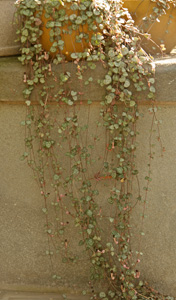
String of Hearts, Ceropegia woodii, is just one of many species in the genus Ceropegia that are grown as ornamental houseplants. Native to southern Africa, from Zimbabwe to eastern South Africa, this tender perennial plant in the milkweed subfamily (Asclepiadoideae) of the dogbane family (Apocynaceae) is sometimes classified as C. linearis subsp. woodii. The genus name was given by Linneaus to describe his interpretation of the appearance of the flowers as fountains of wax from the words keros, meaning wax, and pege meaning fountain. The species name honors John Medley Wood (1827-1915), who collected native African plants after he retired from the East Indian Merchant Service.
Plants in this genus have many other colorful common names including bushman’s pipevine, lantern flower, necklace vine, parachute flower, and wine-glass vine. Rosary vine is another commonly used name for C. woodii, along with chain of hearts, collar of hearts, and hearts entangled (because the stems easily enmesh).
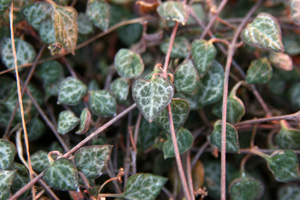
C. woodii, like many other species in this genus, is a straggly evergreen climber that in its native habitat would scramble up through other vegetation. The stringy, purplish stems are vining or trailing, making this best grown as a hanging plant. The stems can also be trained up a small trellis or topiary frame. The simple, opposite heart-shaped leaves are 1-2 cm wide and long. They are dark green marbled with silver on the upper surface and green to purple on the underside. In other species the leaves may be rudimentary or absent, or may be thick, fleshy and succulent. With the tangled, trailing branches that can grow several feet long hanging down, the regularly spaced leaves resemble a row of large beads. Small tubers, which look somewhat like little potatoes, form at the nodes or leaf bases along the stems – another possibility for the “beads” that give rise to the common name of rosary vine.
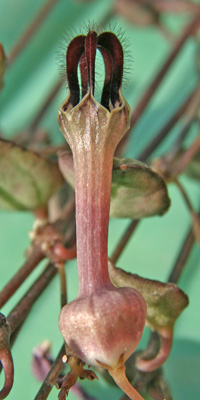
Plants bloom primarily in the summer and fall, but flowers may appear sporadically at odd times throughout the year. The interesting and distinctive inch-long flowers have a bulbous base and tubular corolla in shades of white to pale magenta. The five purple petals are fused at the tips, forming a cage-like canopy so the blossoms resemble a small inverted pink vase. The waxy flowers are lined with small, downward pointing hairs that act to trap small flies that are attracted by the scent and enter the flowers. The insect is prevented from escaping until the hairs wither, and the fly departs with a pollinia (a mass of pollen grains that are transferred as a group) attached that can then be transferred to the next flower the fly visits. Hummingbirds may be attracted to the flowers if the plants are outside during the summer. If pollinated, the flowers are followed by horn-shaped seed pods characteristic of the milkweed family. The stacks of flat seeds each have a pappus – very similar to milkweed seed – that help the seeds disperse on the wind.
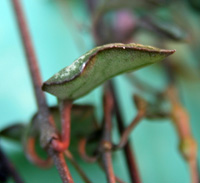
C. woodii is a caudiciform plant, having a swollen basal stem or root for water storage. It develops a woody caudex at its base as it matures. Underground the roots may develop tubers, which can grow to fill a pot.
There are few cultivars of this plant. C. woodii f. variegata has cream and pink variegated leaves.
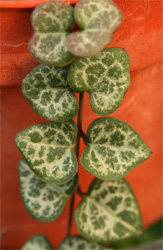
String of hearts can be grown outdoors in tropical or subtropical climates, but is also an easy indoor plant that can be grown in a west or south facing window. In strong light the leaves will be darkly colored, with distinctive marbling; if not given enough light they will be a light green color. Houseplants can be moved outside during the summer, but need to be acclimated gradually to the stronger light to prevent sunburn. If moved outside, be sure to bring indoors before the first frost. During the winter, keep the plants in relatively warm conditions, above 60°F.
This succulent plant requires excellent drainage and should be watered only when dry. It tolerates dry soil much better than soggy soil; it is easily killed by overwatering. Use a freely-draining potting medium with plenty of coarse sand, perlite or other large-textured component to allow for adequate drainage (such as a commercial cacti & succulent mix. Allow the soil to dry between deep waterings. Fertilize infrequently (at most monthly when actively growing) with half strength houseplant fertilizer. Plants do best with a winter rest period. Reduce watering in winter and do not fertilize during this time. This houseplant does best when crowded, so repot only when necessary. Repotting is best done in spring before new growth starts. It has few pests, but mealybugs can be a problem.
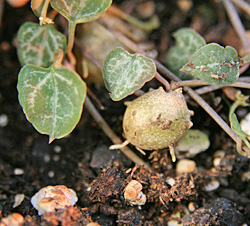
String of hearts is easily propagated from cuttings, from tubers produced at the base of the leaves or by seed. The aerial tubers (“beads”) can be planted to produce new vines. Just press the tuber – preferably still attached to the vine – into the soil of another pot. Keep the growing medium moist, but not wet, to encourage rooting. Once the tuber is rooted and growing in a few weeks or months, sever it from the original plant. Cuttings from the vine are best rooted with bottom heat.
– Susan Mahr, University of Wisconsin – Madison
Ask Your Gardening Question
If you’re unable to find the information you need, please submit your gardening question here:





 Houseplant Care
Houseplant Care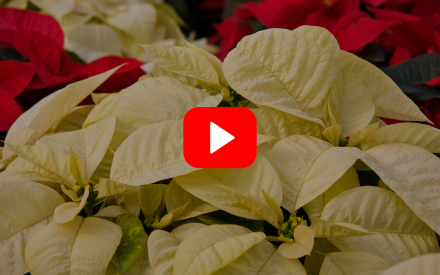 ▶ Watch: Maintaining Your Festive Houseplants
▶ Watch: Maintaining Your Festive Houseplants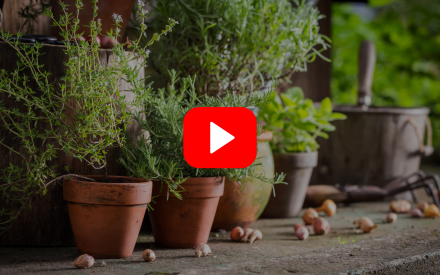 ▶ Watch: Bringing the Garden Inside
▶ Watch: Bringing the Garden Inside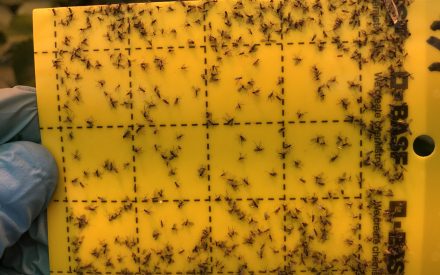 Fungus Gnats on Houseplants
Fungus Gnats on Houseplants


